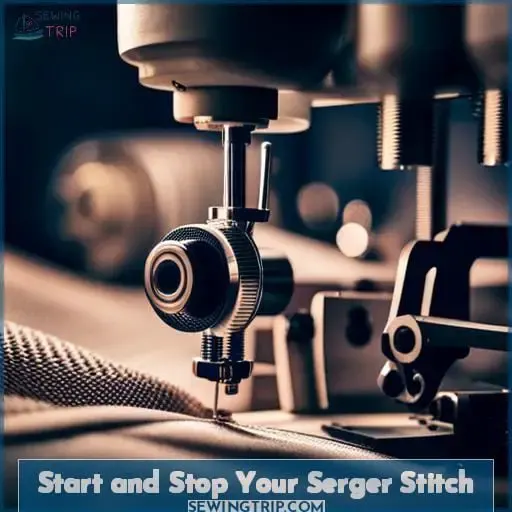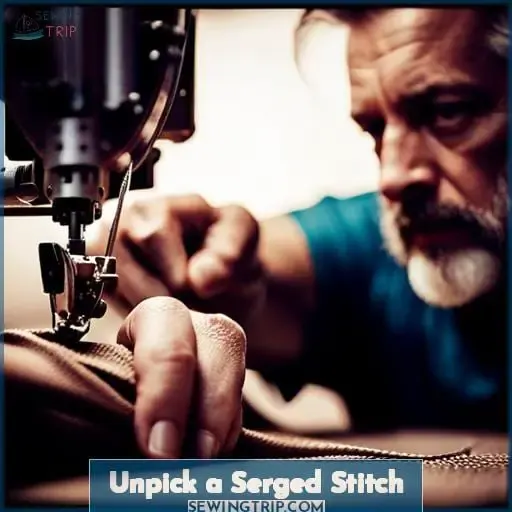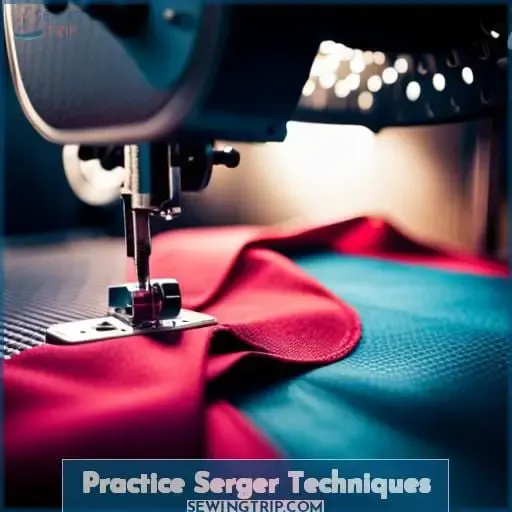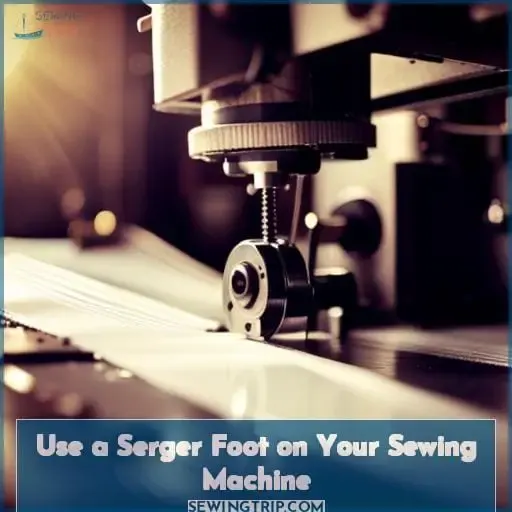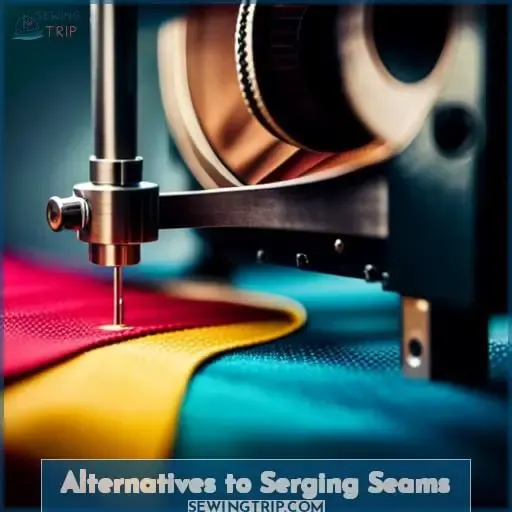This site is supported by our readers. We may earn a commission, at no cost to you, if you purchase through links.
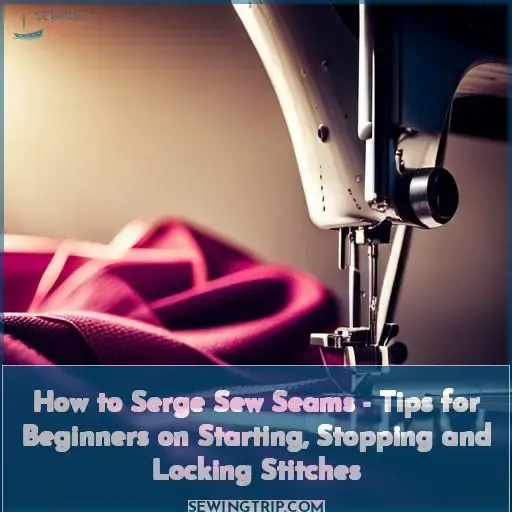
Let’s begin by learning how to:
- Start stitches effortlessly.
- Stop stitches effortlessly.
- Lock stitches effortlessly.
Along the way, we’ll uncover the secrets to unlocking the full potential of your serger.
With a bit of practice, you’ll master the art of serging seams like a pro, leaving you with a polished and professional finish every time.
Table Of Contents
Key Takeaways
- Prepare serger by checking threading, tension, raising presser foot, and using scrap fabric.
- Control starting and stopping serger at fabric edges and mid-fabric.
- Lock stitches by backstitching, chain stitching, or knotting threads.
- Use care unpicking serged seams with a seam ripper and gently lifting threads.
Prepare Your Serger
Preparation of your serger starts with:
- Turning it on
- Ensuring proper threading
- Raising the presser foot
- Obtaining scrap fabric
Before beginning any serging project, it’s key to check that your serger is correctly threaded, including the loopers.
Make sure the thread tension dials are properly set for the fabric you’ll be using so the stitch forms correctly – usually around 3-5 for most fabrics.
Check that the blade is clean and sharp to neatly trim seam allowances as you sew.
Differential feed should be set to N for most sewing; adjust as needed to prevent stretching or puckering.
Always serge test your fabric type with scraps first.
Quality preparation leads to satisfying results. With practice, you’ll learn tricks to achieve a flawless overlocked edge every time.
Proper serger setup truly unlocks the machine’s magical abilities for neatly finishing all raw edges with a professional look.
Start and Stop Your Serger Stitch
When sewing with your serger, you’ll need to learn proper techniques for beginning and ending your seams.
This includes:
- Starting with a raw fabric edge or in the middle of the material
- Stopping at an edge or mid-seam
We’ll go over essential methods for starting and stopping serger stitches smoothly.
Start With a Raw Edge
Having prepared your serger, you’re ready to start serging from a raw fabric edge.
Simply lower the presser foot and begin sewing, allowing the cutters to trim the edge as the seam is formed.
Adjust thread tension as needed, testing on scrap fabric.
Carefully guide the raw edges under the needles to neatly enclose them with thread.
Start in the Middle of Fabric
To start your serger stitch mid-fabric:
- Raise the foot and needles.
- Slide the fabric to the desired starting point.
- Align the seam allowance and blade.
- Lower the foot.
- Begin serging.
Ensure the needle position catches the fabric edge.
Form a small chain for secure stitches.
Line up the fabric layers evenly inside the serged seam allowance area before lowering the presser foot.
Stop at a Raw Edge
You’ll stop your serging at a raw fabric edge by continuing to sew off the end, then cutting the thread chain and locking the stitch.
As you approach the raw edge, keep serging to create a thread chain off the fabric.
Then snip the chains close to the stitching and tie knots at the edge to secure it.
Proper thread tension prevents unraveling.
Choose compatible fabrics, needles, blades, lengths, and widths for flawless finishing.
Stop in the Middle of Fabric
When stopping your serger stitch mid-fabric, keep serging until the needles meet your stopping point.
Then, pull the fabric left while continuing to serge so a thread chain forms that you can trim.
With practice, you’ll learn to manipulate the fabric and control stitch length until the needle position allows a clean stop without unraveling threads.
Minding thread tension prevents messy knots as you pull fabric.
Lock and Finish the Serger Stitch
3 different ways to lock and finish a serged stitch are backstitching, using a chain stitch, and tying a knot.
To backstitch, simply reverse the serger for a few stitches at the end of your seam to lock the threads in place.
For a chain stitch, continue sewing slightly past the fabric edge so the machine forms a thread chain – then snip the chain close to the fabric.
Tying a knot works well too. Leave thread tails long when you finish your seam, then tie the upper looper and lower looper threads together in a square knot.
Whichever method you choose, keep an eye on thread tension, stitch length, and threads to ensure your serged seams look neat and professional.
Experiment on scrap fabric with different techniques until the process becomes second nature.
Mastering how to cleanly lock serger stitches is essential for achieving expert, long-lasting seams on all fabric types using your preferred seam allowance.
With practice, you’ll refine your serger basics and finishing skills.
Unpick a Serged Stitch
You can unpick a serged stitch using a seam ripper.
Cut the serged seam allowance.
Pull the serger threads to unravel the seam.
Trim any remaining threads.
Press the fabric flat.
To unpick the serged stitch, first use a seam ripper to gently lift the serged threads.
Take care not to damage the fabric.
Then cut through the serged seam allowance about 1 cm away from the seam.
This will release the tight serged threads so you can easily pull them out.
Grasp the looper threads and gently pull to unravel the serged seam.
Use small scissors to clip any stubborn threads still caught in the fabric.
Remove all residual threads so the fabric is smooth.
Give the fabric a final press with the iron to flatten it out after unpicking the stitching.
Proper unpicking of the serged seam will allow you to reuse the fabric and serge a new seam with precision.
Selecting quality, strong threads can help avoid the need to unpick serged seams.
But knowing how to properly unpick the stitch without damaging the fabric salvage is an essential serger skill for any project.
Practice Serger Techniques
Practice starting and stopping with raw edges and in the middle of fabric. Then, try locking the serger stitch using each method to choose what you find most comfortable.
When practicing precision stitching on your serger, focus on the following elements of technique:
- Stitch precision: Keep stitches straight, even, and properly spaced. Adjust thread tension as needed.
- Thread tension: Balanced tension prevents puckering and uneven stitches. Make small adjustments and retest.
- Speed control: Sew slowly until comfortable with serger function. Faster speeds come with experience.
- Fabric handling: Don’t pull or push fabric. Let the machine feed it smoothly.
- Blade maintenance: Regularly clean and oil the blade for smooth cutting action.
Use scrap fabric to practice starting, stopping, and locking stitches until it becomes second nature.
Compare Serging to Overlocking
Next, you’d compare serging to overlocking to understand how they differ in finishing raw edges.
While both enclose and reinforce edges, overlocking offers more fabric versatility and easier stitch adjustment.
Overlocking uses the sewing machine‘s built-in overcast stitch options to bind edges.
Serging, however, trims the edge as the seam is stitched. Its looped thread casing gives greater edge enclosure and a more pronounced, professional finish.
The dedicated serger also allows easy stitch length and width changes for different fabrics.
Both create nice looking seams that lie flat, but serging’s narrower seam allowance and trimmed edge generally looks cleaner.
Consider overlocking for basic seams and serging for a high-quality edge on fine fabrics.
Experiment with your sewing machine’s stitches first before investing in a serger to meet your project’s seam finish needs.
Use a Serger Foot on Your Sewing Machine
You can achieve a similar finish to serging using a serger or overcast foot on your regular sewing machine.
Simply swap out the regular presser foot for a serger foot. This specialized foot helps guide the fabric edge neatly along the stitching plate.
Choose a stitch like an overlock, overcast, or zigzag satin.
Test sew on scrap fabric to compare the stitch appearance.
The serger foot prevents fabric from bunching and maintains flat seams.
Take it slowly on curves.
Certain fabrics like lightweight wovens and slippery synthetics do best with the serger foot for a professional look.
Get creative with thread colors for decorative finishes.
If skipped stitches occur, adjust tension or switch to a new needle.
With some practice, you’ll achieve serger-quality results utilizing stitches and tools you already have.
Alternatives to Serging Seams
Having tried using a serger foot on your sewing machine, consider other alternatives to serging seams for finishing raw edges neatly:
- Hand stitching methods like blanket stitch and whip stitch provide a neat handmade finish.
- Seam treatments such as binding ribbon, fray block liquid, and washaway tape enclose raw edges.
- Specialty machine stitches like zigzag satin stitch and triple straight stitch mimic a serger’s clean finish.
While a serger creates professionally finished seams and prevents fraying, explore other options if you don’t own this specialty equipment. With a bit of creativity, you can find alternative edge finishing techniques for any fabric or project.
Focus on choosing the method that best suits your sewing skills, desired finish, and available tools.
Frequently Asked Questions (FAQs)
What types of threads and needles should I use in my serger?
Use polyester or cotton serger thread, which is stronger, and serger needles, such as Schmetz ELx705 size 80/
Test on fabric scraps first and adjust tension based on the results.
Sharp needles and quality serger thread will give you the best performance.
How do I adjust the tension on a serger to fix problems like looping stitches or skipped stitches?
Check your serger’s manual for recommended tension settings.
Make minor adjustments, testing after each change.
Increase the needle tension if you see looping on the underside.
Reduce the lower looper tension if the upper thread is skipping stitches.
What are some tips for sewing curves and corners with a serger?
Slow down and gently guide the fabric.
Trim seam allowances smaller.
Use lots of pins to prevent shifting.
Adjust presser foot pressure if needed.
Practice makes perfect!
How often does the serger need to be cleaned and oiled for maintenance?
Clean and oil your serger monthly.
This regular maintenance keeps the machine running smoothly and prevents lint and thread remnants from building up inside.
Use the manufacturer’s recommended lubricant on moving parts.
More frequent oiling may be needed during periods of heavy serging.
Proper care extends your machine’s life.
Are there any accessories, feet, or attachments that are useful to have for a serger?
Yes! Specialty feet like the blind hem and piping feet let you get creative and expand your serging abilities.
The gathering foot helps ease fabric fullness for a smooth serged finish.
With the right accessories, you’ll take your serging skills to the next level.
Conclusion
Once you get the hang of it, serging seams will be like slicing through butter.
With some practice starting, stopping, and locking stitches, you’ll gain confidence in serging and be able to achieve a professional, polished finish.
Remember to go slow as you learn – serging is an art, not a race.
Don’t be afraid to use scraps to practice serging techniques.
Soon it’ll become second nature to serge sew for flawless seams every time.


